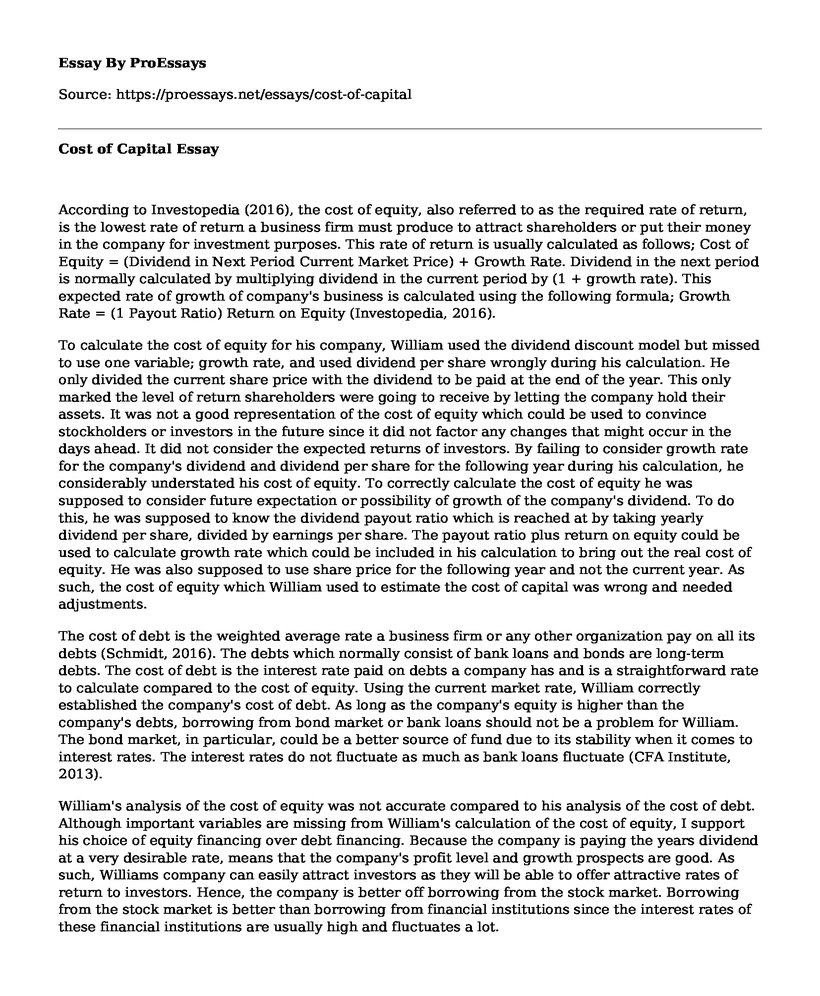According to Investopedia (2016), the cost of equity, also referred to as the required rate of return, is the lowest rate of return a business firm must produce to attract shareholders or put their money in the company for investment purposes. This rate of return is usually calculated as follows; Cost of Equity = (Dividend in Next Period Current Market Price) + Growth Rate. Dividend in the next period is normally calculated by multiplying dividend in the current period by (1 + growth rate). This expected rate of growth of company's business is calculated using the following formula; Growth Rate = (1 Payout Ratio) Return on Equity (Investopedia, 2016).
To calculate the cost of equity for his company, William used the dividend discount model but missed to use one variable; growth rate, and used dividend per share wrongly during his calculation. He only divided the current share price with the dividend to be paid at the end of the year. This only marked the level of return shareholders were going to receive by letting the company hold their assets. It was not a good representation of the cost of equity which could be used to convince stockholders or investors in the future since it did not factor any changes that might occur in the days ahead. It did not consider the expected returns of investors. By failing to consider growth rate for the company's dividend and dividend per share for the following year during his calculation, he considerably understated his cost of equity. To correctly calculate the cost of equity he was supposed to consider future expectation or possibility of growth of the company's dividend. To do this, he was supposed to know the dividend payout ratio which is reached at by taking yearly dividend per share, divided by earnings per share. The payout ratio plus return on equity could be used to calculate growth rate which could be included in his calculation to bring out the real cost of equity. He was also supposed to use share price for the following year and not the current year. As such, the cost of equity which William used to estimate the cost of capital was wrong and needed adjustments.
The cost of debt is the weighted average rate a business firm or any other organization pay on all its debts (Schmidt, 2016). The debts which normally consist of bank loans and bonds are long-term debts. The cost of debt is the interest rate paid on debts a company has and is a straightforward rate to calculate compared to the cost of equity. Using the current market rate, William correctly established the company's cost of debt. As long as the company's equity is higher than the company's debts, borrowing from bond market or bank loans should not be a problem for William. The bond market, in particular, could be a better source of fund due to its stability when it comes to interest rates. The interest rates do not fluctuate as much as bank loans fluctuate (CFA Institute, 2013).
William's analysis of the cost of equity was not accurate compared to his analysis of the cost of debt. Although important variables are missing from William's calculation of the cost of equity, I support his choice of equity financing over debt financing. Because the company is paying the years dividend at a very desirable rate, means that the company's profit level and growth prospects are good. As such, Williams company can easily attract investors as they will be able to offer attractive rates of return to investors. Hence, the company is better off borrowing from the stock market. Borrowing from the stock market is better than borrowing from financial institutions since the interest rates of these financial institutions are usually high and fluctuates a lot.
Reference
CFA Institute (2013). Cost of capital. Retrieved from https://www.cfainstitute.org/learning/products/publications/inv/Documents/corporate_finance_chapter3.ppt
Investopedia (2016). Cost of Equity. Retrieved fromhttp://www.investopedia.com/terms/c/costofequity.asp
Schmidt, M. (2016). Cost of Capital, Cost of Borrowing, and Similar "Cost of" Terms Explained. Retrieved from https://www.business-case-analysis.com/cost-of-capital.html
Cite this page
Cost of Capital. (2021, Mar 15). Retrieved from https://proessays.net/essays/cost-of-capital
If you are the original author of this essay and no longer wish to have it published on the ProEssays website, please click below to request its removal:
- Financial Investment
- Nike Acquiring Lululemon
- Analysing Financial Information
- Reflection on the Two WorldCom Readings Paper Example
- Swiss Proposal of Amending Banking Practice as We Know It Essay
- Stock Valuations Paper Example
- Essay on Healthy Eating on a Budget: Peanut Butter, Unsalted Pepitas & Flax Seeds







